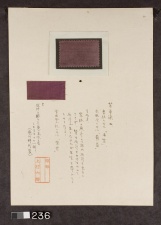Difference between revisions of "Shikon (Gromwell root) - bottom (236 B)"
Jump to navigation
Jump to search
(username removed) |
(username removed) |
||
| Line 5: | Line 5: | ||
| 236 | | 236 | ||
|- | |- | ||
| − | ! scope="row"| | + | ! scope="row"|Uemura number / title |
| − | | | + | | ; "Haze-some 25" |
|- | |- | ||
! scope="row"|Folder location | ! scope="row"|Folder location | ||
| Line 44: | Line 44: | ||
| vinegar (separate bath) | | vinegar (separate bath) | ||
|- | |- | ||
| − | ! scope="row"| | + | ! scope="row"|Uemura's notes |
| By using both vinegar and ash water in the dyeing process, the resultant color became more red. This is an example of dyeing technique from the Edo period (the 16 -19th century AD), Japan. | | By using both vinegar and ash water in the dyeing process, the resultant color became more red. This is an example of dyeing technique from the Edo period (the 16 -19th century AD), Japan. | ||
|- | |- | ||
| − | ! scope="row"| | + | ! scope="row"|Uemura's date |
| Kyoto | | Kyoto | ||
|} | |} | ||
| − | [[Category: | + | [[Category:Uemura dye archive]] |
Revision as of 07:19, 24 July 2013
| Museum number | 236 |
|---|---|
| Uemura number / title | ; "Haze-some 25" |
| Folder location | 4th shelf |
| Sample location | bottom (236 B) |
| Fiber type | silk |
| Color | reddish purple |
| Dyestuff (Japanese common name) | 紫根 : Shikon |
| Dye (English common name) | Gromwell root |
| Dyestuff (botanical name) | Lithospermum erythrorhizon Siebold et Zucc. (L. officinale L. subsp. erythrorhizon (Siebold et Zucc.) Hand.-Mazz.) |
| Plant part | root / dried (?) |
| Dyestuff extraction | boiled in water, and dyed in warm bath |
| Auxiliary agent in dye bath | - |
| Mordant | ash water |
| Other auxiliary agent | vinegar (separate bath) |
| Uemura's notes | By using both vinegar and ash water in the dyeing process, the resultant color became more red. This is an example of dyeing technique from the Edo period (the 16 -19th century AD), Japan. |
| Uemura's date | Kyoto |
